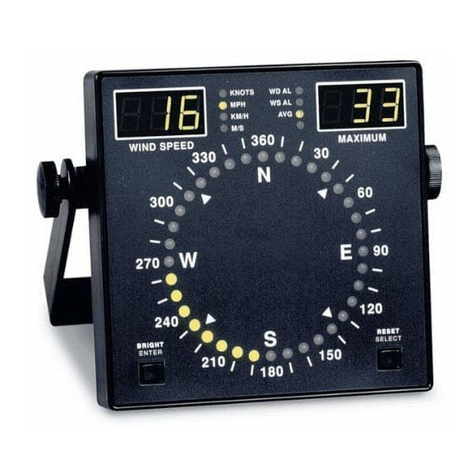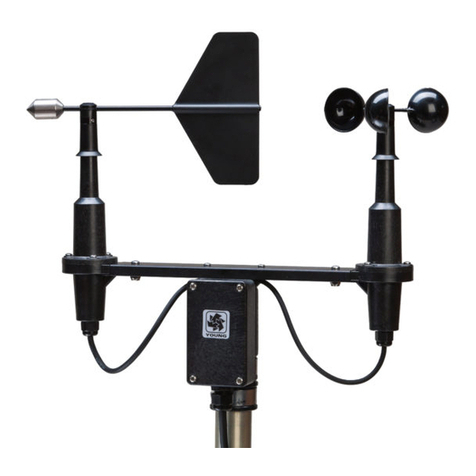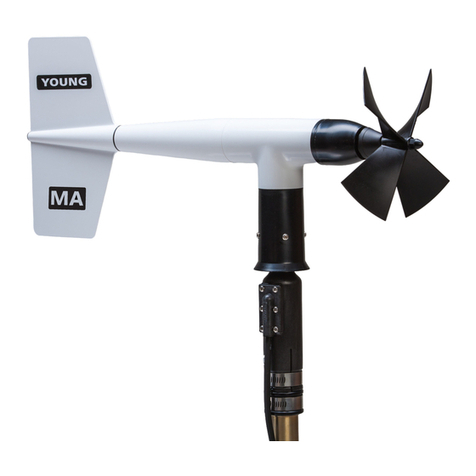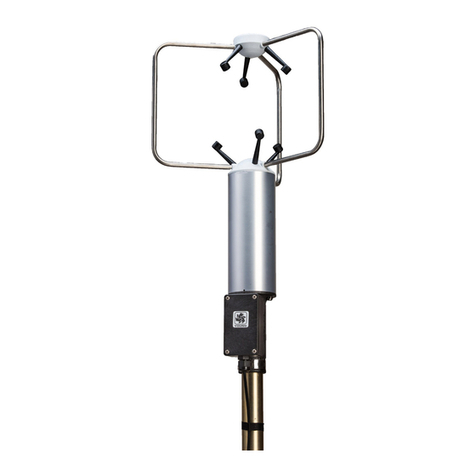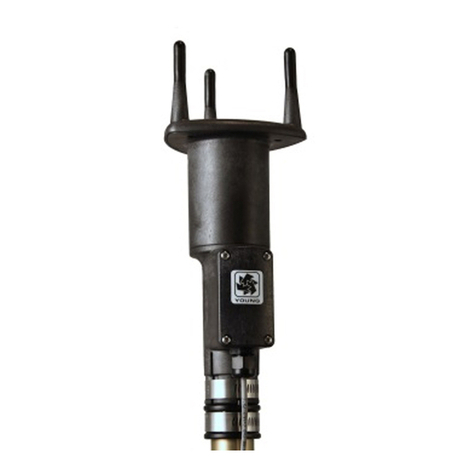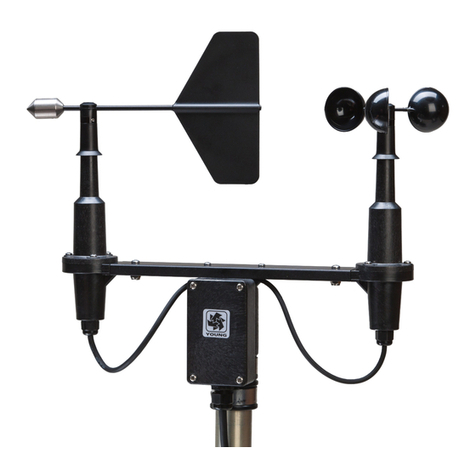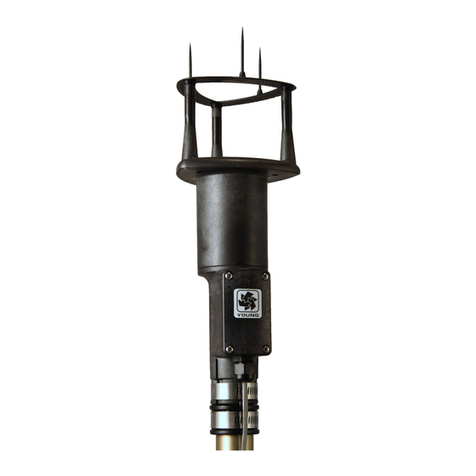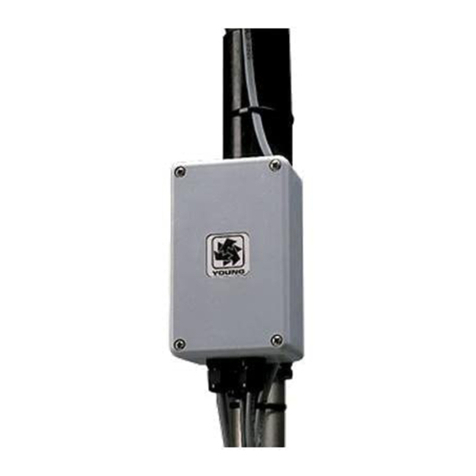
Page 5
91000-90(B)
SDI-12 Measurement commands and responses are listed below.
COMMAND RESPONSE DESCRIPTION
aM! attts<CR><LF> Take a measurement
aMC! attts<CR><LF> Take a measurement with CRC
checksum
aC! atttss<CR><LF> Take a concurrent measurement
aCC! atttss<CR><LF> Take a concurrent measurement
with CRC checksum
aD0! a+www.ww+ddd.d<CRC><CR><LF> (Polar)
a±uu.uu±vv.vv<CRC><CR><LF> (Cartesian)
where:
a = Sensor address
ttt = Delay time (seconds)
s/ss = Number of samples to collect
www.ww = Wind speed (selected units)
ddd.d = Wind direction (degrees)
±uu.uu = U-axis wind speed (m/s)
±vv.vv = V-axis wind speed (m/s)
<CRC> = CRC checksum (only where requested)
<CR><LF> = Carriage return, line feed (ASCII 13, 10)
Wind data format depends on the sensor Output Format parameter
setting (Polar or Cartesian).
5.2.2 SDI-12 NON-MEASUREMENT COMMANDS
The SDI-12 protocol includes standard commands for identifying the
sensor and changing its address.
COMMAND RESPONSE DESCRIPTION
?! a<CR><LF> Address Query
a! a<CR><LF> Acknowledge Active
aI! a13 YOUNG C091000 vvvnnnnnn<CR><LF>
Send Identication
vvv = Firmware Version
nnnnnn = Serial Number
aAb! b<CR><LF> Change Address
a = Sensor address
b = New sensor address
aV! a0000<CR><LF> Start Verication
5.2.3 EXTENDED COMMANDS
The SDI-12 command set may be customized with Extended
Commands to accommodate manufacturer settings and other
functions. Extended Commands are listed below. Where two
responses are shown, one is for a valid command, the other is for
an invalid (ERR) command.
COMMAND RESPONSE DESCRIPTION
aXB! aXB, OK<CR><LF> Save parameter settings to ash.
aXFn! aXF, F=n<CR><LF> n = Output Format code.
0 or 1 (Polar or Cartesian)
aXF,ERR F=0/1<CR><LF>
aXPn! Parameter report, 4 reports needed for all parameters
aXP1,F=f,UW=uw,T=t,S=s,W=w,CE=ce<CR><LF>
a = Sensor address
f = Wind Format
uw = Polar wind speed units
1=mph
2=knots
3=km/h
4=m/s
t = Threshold, polar only (0-150 cm/s)
s = Sample count, internal (1-800)
w = Wait (seconds)
ce=Compass Enable
aXP2,OD=od,M=m,CD=cd,PWR=v VDC<CR><LF>
od=WD Offset
m=WS Multiplier
cd=Compass Declination
v=Supply Voltage
aXPn,ERR n=1/2/3/4 ONLY<CR><LF>
aXSnnn! nnn = Sample Count (001-800 samples)
aXS,S=nnn<CR><LF>
aXS,ERR S=001-800 ONLY<CR><LF>
aXMnnnnn! nnnnn=WS multiplier x 10000 (00000 - 30000)
aXM,M=nnnnn<CR><LF>
aXM,ERR M=00000-30000 ONLY<CR><LF>
aXTnnn! nnn = Wind Speed Threshold (000 - 150 cm/s)
aXT,T=nnn<CR><LF>
aXT,ERR T=000-150 ONLY<CR><LF>
aXUWn! n = Wind Speed Units
(1=mph, 2=knots, 3=kmph, 4=m/s)
aXUW,UW=n<CR><LF>
aXUW,ERR UW=1/2/3/4 ONLY<CR><LF>
aXOD±nnnn! ±nnnn = Wind Direction Offset x 10 (-3600 to
3600) aXOD,OP=±nnnn<CR><LF>
aXOD,ERR OD=-3600 - +3600
ONLY<CR><LF>
aXCEn! n = Compass Enable (0=Disable, 1=Enable)
aXCE,CE=n<CR><LF>
aXCE,ERR CE=0/1 ONLY<CR><LF>
aXCDnddmm! nddmm = Declination (n=E/W/0,dd=DEG,
mm=MIN) aXCD,CD=nddmm<CR><LF>
aXCD,ERR CD=nddmm n=E/W/0, dd=00-
90, mm=00-60 ONLY<CR><LF>
IMPORTANT! PARAMETER CHANGES MUST BE STORED IN
FLASH MEMORY USING THE aXB! COMMAND OR THEY WILL
REVERT TO PREVIOUSLY STORED VALUES AT POWER UP.
The aXB! command may be sent after all changes have been
made, or not sent at all if the changes are temporary.
SAMPLE COUNT (aXSnnn!)
Each wind measurement is calculated from the median of multiple
wind samples. Each sample requires a power pulse so more samples
consume more power. The default sample count of 16 is a good
balance of low power consumption and robust performance. If winds
above 30 m/s are expected, 100 samples may be more suitable.
Winds reaching the performance limit of the sensor (70 m/s) may
require a setting of up to 800 samples.
THRESHOLD (aXTnnn!)
Threshold sets the minimum wind speed needed before a new polar
wind direction is calculated. The default value is 25 cm/s (0.25 m/s). A
greater-than-zero threshold can help provide more meaningful scalar
wind direction averages. The threshold for Cartesian (UV) output
format is automatically zero regardless of this setting.
5.3 LOW POWER OPERATION
Average current consumption with default settings is about 7.5 mA.
This conguration uses minimal power and enables all features even
though they may not be used. This is suitable for many low power
applications.
To reduce current consumption further, additional strategies include
disabling unused outputs, using polled serial operation, increasing
the output interval, and limiting the sample count to the minimum
optimal number. Faster baud rates also reduce power by limiting
transmit duration.
